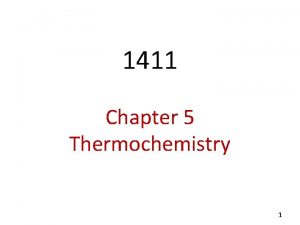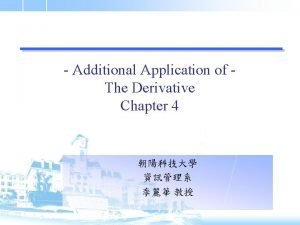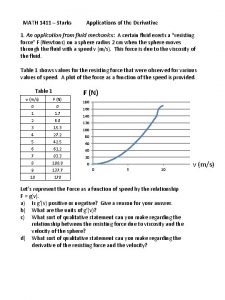MATH 1411 Starks Applications of the Derivative 1



- Slides: 3

MATH 1411 – Starks Applications of the Derivative 1. An application from fluid mechanics: A certain fluid exerts a “resisting force” F (Newtons) on a sphere radius 2 cm when the sphere moves through the fluid with a speed v (m/s). This force is due to the viscosity of the fluid. Table 1 shows values for the resisting force that were observed for various values of speed. A plot of the force as a function of the speed is provided. Table 1 F (N) v (m/s) F (N) 0 0 1 1. 7 2 6. 8 3 15. 3 4 27. 2 5 42. 5 6 61. 2 40 7 83. 3 20 8 108. 8 0 9 137. 7 10 170 180 160 140 120 100 80 60 0 5 10 Let’s represent the Force as a function of speed by the relationship F = g(v). a) Is g’(v) positive or negative? Give a reason for your answer. b) What are the units of g’(v)? c) What sort of qualitative statement can you make regarding the relationship between the resisting force due to viscosity and the velocity of the sphere? d) What sort of qualitative statement can you make regarding the derivative of the resisting force and the velocity? v (m/s) 15

2. Momentum and Force of a Particle: Consider a particle whose mass is m (kg) that moves with a speed of v (m/s). The scalar momentum, denoted by p, is defined as p = mv. The time rate of change of momentum of a particle is equal to the scalar force that acts on the particle. Table 2 shows measurements of the scalar momentum at a number of points of time t (s). Table 2 t (s) 0 1 2 3 4 5 6 7 8 9 10 11 12 13 14 15 16 a) b) c) d) e) p (kg-m/s) 0. 0 3. 5 5. 0 3. 6 0. 1 -3. 5 -5. 0 -3. 6 -0. 1 3. 4 5. 0 3. 6 0. 2 -3. 4 -5. 0 -3. 7 -0. 2 p (kg-m/s) 6, 0 4, 0 2, 0 0 5 10 15 -2, 0 -4, 0 -6, 0 What are the units of the scalar force? When is the scalar force equal to zero? When is the value of the scalar force at a maximum? When is the value of the scalar force at a minimum? Describe qualitatively how the scalar force varies with time. t (s)20

3. Potential Energy and Power: The potential energy V (Joules) of a object of mass m (kg) located at a height h (m) is given by the relationship: V=m g h. Here g denotes the gravitational constant 9. 8 m/s 2. For this problem, power P (Watts) is defined as the time rate of change of potential energy. A construction crew plans to raise a beam from the ground using a crane. The figure shows a plot the potential energy V (Joules) of the beam versus time t (s). Determine the power supplied by the crane as it raises the beam for the following time periods: 0 < t < 10; 10 < t < 30; 30 <t < 50; 50 < t < 60; 60 < t < 90.





